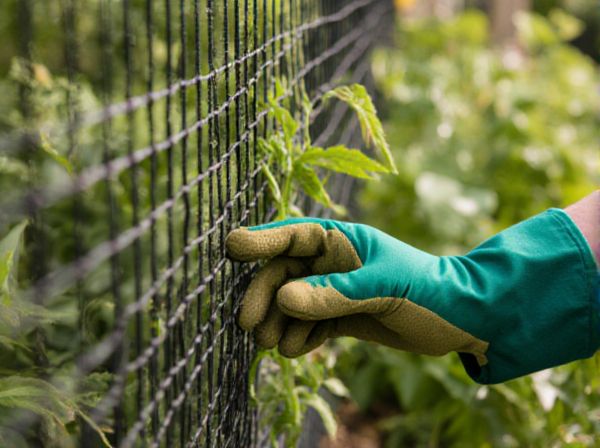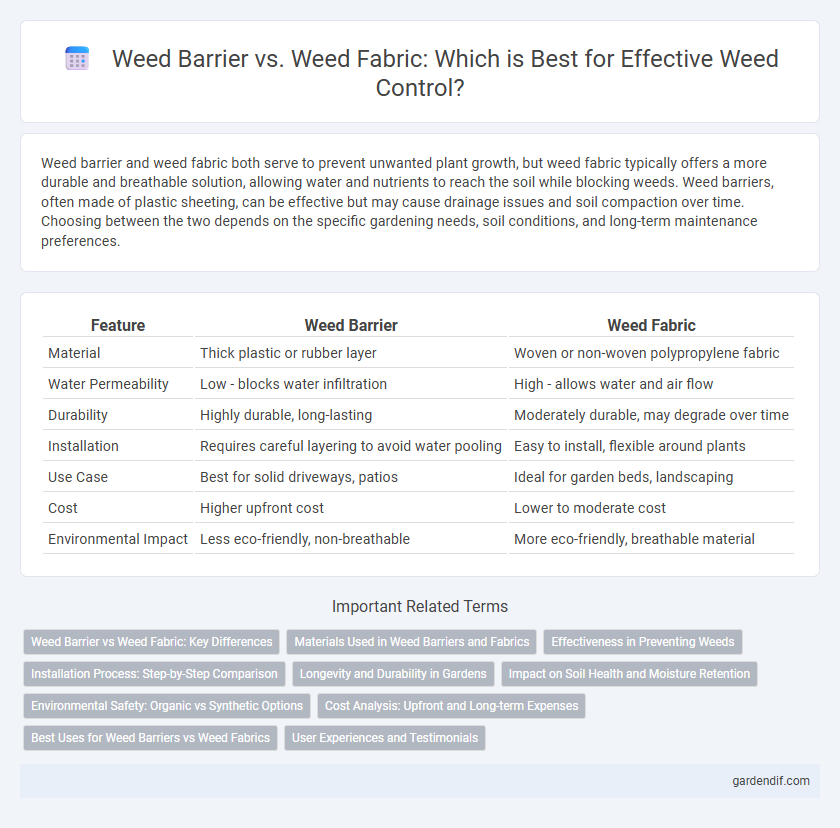
Weed barrier vs Weed fabric Illustration
Weed barrier and weed fabric both serve to prevent unwanted plant growth, but weed fabric typically offers a more durable and breathable solution, allowing water and nutrients to reach the soil while blocking weeds. Weed barriers, often made of plastic sheeting, can be effective but may cause drainage issues and soil compaction over time. Choosing between the two depends on the specific gardening needs, soil conditions, and long-term maintenance preferences.
Table of Comparison
| Feature | Weed Barrier | Weed Fabric |
|---|---|---|
| Material | Thick plastic or rubber layer | Woven or non-woven polypropylene fabric |
| Water Permeability | Low - blocks water infiltration | High - allows water and air flow |
| Durability | Highly durable, long-lasting | Moderately durable, may degrade over time |
| Installation | Requires careful layering to avoid water pooling | Easy to install, flexible around plants |
| Use Case | Best for solid driveways, patios | Ideal for garden beds, landscaping |
| Cost | Higher upfront cost | Lower to moderate cost |
| Environmental Impact | Less eco-friendly, non-breathable | More eco-friendly, breathable material |
Weed Barrier vs Weed Fabric: Key Differences
Weed barrier and weed fabric both serve to suppress weed growth but differ in material and permeability; weed barrier is typically a solid, impermeable plastic sheet blocking all light and moisture, preventing weed emergence completely. Weed fabric, usually made of woven or non-woven polypropylene, allows water and air to penetrate, promoting soil health while restricting weed growth. Choosing between the two depends on specific gardening needs such as drainage requirements and long-term soil aeration.
Materials Used in Weed Barriers and Fabrics
Weed barriers are typically made from thicker, woven polypropylene or polyethylene materials designed to physically block weed growth by creating a durable, impermeable layer. Weed fabrics often utilize lighter, spunbonded polypropylene or biodegradable natural fibers that allow water and air to pass through while restricting weed roots. The choice of material impacts durability, water permeability, and environmental sustainability in weed control applications.
Effectiveness in Preventing Weeds
Weed barriers are typically made of thicker, more durable materials that block sunlight entirely, preventing any weed growth by creating an impermeable layer. Weed fabrics, often lighter and more porous, allow water and air to pass through but still inhibit weed emergence by blocking most sunlight. For maximum effectiveness in preventing weeds, barriers provide a stronger physical blockade, while fabrics balance weed control with soil health through permeability.
Installation Process: Step-by-Step Comparison
Installing weed barriers involves laying thick plastic sheets that block sunlight and sealing edges with landscape staples to prevent weed growth. Weed fabric requires securing the permeable material with fabric pins, ensuring proper overlap to allow water drainage while inhibiting weeds. Both methods emphasize precise placement and anchoring, but weed fabric installation demands more careful alignment for optimal breathability and soil moisture retention.
Longevity and Durability in Gardens
Weed barriers typically offer superior longevity and durability compared to weed fabrics due to their thicker, more robust materials designed to withstand heavy foot traffic and harsh weather conditions in gardens. Weed fabrics, often made from lighter woven or non-woven polypropylene, provide good weed control but tend to degrade faster under prolonged UV exposure and frequent moisture. Choosing a high-quality, UV-stabilized weed barrier can significantly extend the life of garden weed control, reducing the need for frequent replacements.
Impact on Soil Health and Moisture Retention
Weed barrier and weed fabric differ significantly in their impact on soil health and moisture retention, with weed fabrics typically allowing better air and water permeability, promoting healthier root growth and soil microbial activity. Weed barriers, often made from impermeable plastic, can trap moisture beneath the surface but may lead to soil compaction and reduced oxygen availability, negatively affecting soil structure and plant health. Choosing breathable weed fabric enhances moisture retention while maintaining soil aeration, essential for sustainable garden ecosystems.
Environmental Safety: Organic vs Synthetic Options
Weed barriers and weed fabrics differ significantly in environmental safety, with organic options such as biodegradable coconut coir or jute providing eco-friendly alternatives that decompose naturally, minimizing synthetic waste. Synthetic weed fabrics, often made from polypropylene or polyester, offer durability and long-term weed suppression but pose environmental concerns due to their non-biodegradable nature and pollution potential. Choosing organic weed barriers supports sustainable gardening by enhancing soil health and reducing plastic pollution, aligning with eco-conscious landscaping practices.
Cost Analysis: Upfront and Long-term Expenses
Weed barriers typically have a higher upfront cost due to thicker materials and greater durability, while weed fabric offers a more budget-friendly initial investment with thinner, less expensive material. Long-term expenses for weed barriers tend to be lower because of their extended lifespan and reduced need for replacement or maintenance. Considering both upfront and ongoing costs, weed barriers may offer better value for heavy-duty landscaping projects, whereas weed fabric suits smaller, short-term gardening needs.
Best Uses for Weed Barriers vs Weed Fabrics
Weed barriers, typically made from thicker materials like plastic or rubber, excel in areas requiring long-term prevention of weed growth and soil moisture retention, such as under patios or driveways. Weed fabrics, made from woven or non-woven polypropylene, are ideal for garden beds and flowerbeds where breathability and water permeability are crucial to promoting healthy plant roots. Choosing between weed barriers and weed fabrics depends on balancing longevity and soil health needs in landscaping projects.
User Experiences and Testimonials
Users report that weed barrier effectively blocks sunlight, significantly reducing weed growth in gardens and pathways, with many praising its durability in various weather conditions. Testimonials highlight weed fabric's ease of installation and flexibility, making it ideal for flower beds and vegetable gardens, although some users note its susceptibility to tearing under heavy foot traffic. Overall, gardeners value weed barriers for long-term performance, while weed fabric receives positive feedback for quick setup and adaptability.
Weed barrier vs Weed fabric Infographic

 gardendif.com
gardendif.com